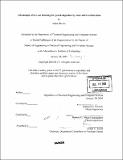| dc.contributor.advisor | Nathaniel I. Durlach and Barbara G. Shinn-Cunningham. | en_US |
| dc.contributor.author | Devore, Sasha | en_US |
| dc.contributor.other | Massachusetts Institute of Technology. Dept. of Electrical Engineering and Computer Science. | en_US |
| dc.date.accessioned | 2006-07-13T15:13:28Z | |
| dc.date.available | 2006-07-13T15:13:28Z | |
| dc.date.copyright | 2005 | en_US |
| dc.date.issued | 2005 | en_US |
| dc.identifier.uri | http://hdl.handle.net/1721.1/33298 | |
| dc.description | Thesis (M. Eng.)--Massachusetts Institute of Technology, Dept. of Electrical Engineering and Computer Science, 2005. | en_US |
| dc.description | Includes bibliographical references (leaves 66-69). | en_US |
| dc.description.abstract | The current study investigates how the spatial locations of a target and masker influence consonant identification in anechoic and reverberant space. Reverberation was expected ·to interfere with the task both directly by degrading consonant identification and indirectly by altering interaural cues and decreasing spatial unmasking. Performance was measured as a function of target-to-masker ratio (TMR) to obtain multiple points along the psychometric function. Results suggest that for consonant identification, there is little spatial unmasking; however, in reverberant environments, performance improves with binaural listening even when the target and masker give rise to roughly the same interaural cues. It is hypothesized that the time-varying changes in TMR at both ears that result from reverberation can lead to such binaural listening advantages. The behavioral results are discussed with respect to an acoustic analysis that quantifies the expected improvement of binaural listening over monaural listening using an "independent looks" approach. | en_US |
| dc.description.statementofresponsibility | by Sasha Devore. | en_US |
| dc.format.extent | 69 leaves | en_US |
| dc.format.extent | 2988794 bytes | |
| dc.format.extent | 2991192 bytes | |
| dc.format.mimetype | application/pdf | |
| dc.format.mimetype | application/pdf | |
| dc.language.iso | eng | en_US |
| dc.publisher | Massachusetts Institute of Technology | en_US |
| dc.rights | M.I.T. theses are protected by copyright. They may be viewed from this source for any purpose, but reproduction or distribution in any format is prohibited without written permission. See provided URL for inquiries about permission. | en_US |
| dc.rights.uri | http://dspace.mit.edu/handle/1721.1/7582 | |
| dc.subject | Electrical Engineering and Computer Science. | en_US |
| dc.title | Advantages of two-ear listening for speech degraded by noise and reverberation | en_US |
| dc.type | Thesis | en_US |
| dc.description.degree | M.Eng. | en_US |
| dc.contributor.department | Massachusetts Institute of Technology. Department of Electrical Engineering and Computer Science | |
| dc.identifier.oclc | 62279297 | en_US |
